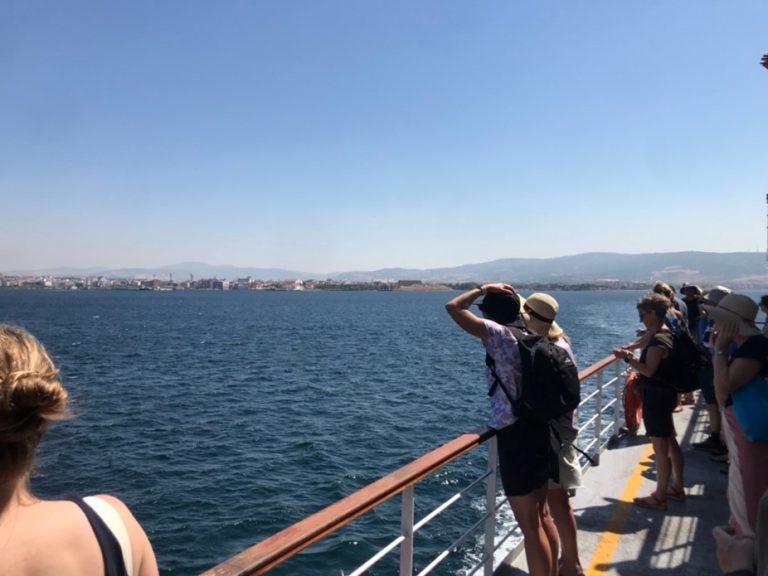Swimming
Swimming is very much part of the Australian culture, whether it be solitary or social, in the pool or the sea, for a casual dip or for competition. Whatever the setting, we all have our goals. I was introduced to open water swimming about 14 years ago by my oldest daughter and once I had got over my Jaws-induced fear of deep water, I’ve been an addict. Each year I try to do a “special” swim – whether it be interstate or overseas, but the top of my bucket-list has always been the Dardanelles. I was lucky enough to be able to tick it off a few months ago.
The Dardanelles is part of the natural waterway which divides Turkey in two, forming part of the continental and cultural boundary between Europe and Asia. It has been the subject of Greek mythology, famous battles, and great conquests, but it was the English poet Lord Byron’s swim across the six and a half kilometres of the tumultuous strait in 1810 that placed it on top of many open water swimmer’s bucket list. He did this to honour the mythological Leander, who swam the strait nightly to visit his beloved Hero, a priestess of Aphrodite. The story of their forbidden love ended abruptly when Leander was drowned attempting the crossing in stormy weather. For the last 36 years the local Rotary Club has run a public swim across the strait from Eceabat to Canakkale to mark the anniversary of the founding of the modern state of Turkey in 1923. It is an importantly symbolic event in Turkey, necessitating the closure of one of the world’s busiest shipping channels. 2023 was the centenary of “Victory Day”. Whilst the swim is designed for Turks, it is open to some foreigners, and I was fortunate in obtaining an entry through Swimtrek, a British swim tour company.
Like most of the other swimmers, I arrived in Canakkale two days before the swim. Whilst there is no tide to speak of, the current streams flowing through strait are swift and complex, with a surface current flowing southwards and a deeper current flowing northward. The currents occasionally spin off into giant eddies. Thankfully, the swim guides offered a briefing and “planning” trip on the local ferry the day before the swim. We were told that a fleet of fishing boats would bracket the course and given a complex series of sightings and turning points to use the currents to our advantage.

History and Culture
The historical and cultural importance of the area swiftly revealed itself over next few days. A giant Trojan horse, built for the epic 2004 film starring Brad Pitt and Eric Bana, stands on the waterfront. The ancient site of Troy, first occupied around 3600 BC, is just a few kilometres from Canakkale itself and well worth a visit. The strait itself was also the site of a pontoon bridge ordered by Xerxes I of Persia for his ultimately doomed invasion of Greece in 480 BC. When the bridge was swept away by a storm, he famously had its builders beheaded and punished the waters with three hundred whiplashes.

The Day
On the day of the swim, I joined the 800 other barefooted swimmers wearing only togs, each carrying goggles, cap and a timing band who crowded onto the ferry to cross to Eceabat. No wet suits or smart watches allowed. From there, it was only a short walk to the starting gate and time-pad. A dozen or so para-swimmers set off first, followed by a charge of keen young Turks. I started behind the melee to ensure some clean water as I had been planning to do the whole swim in breaststroke.
Lord Byron, despite being born with a clubfoot, was a prodigious swimmer, having already undertaken a “great waterways” swimming tour of Europe, including breast stroking the length of the Grand Canal in Venice in formal clothes with a cravat. Breaststroke was the fastest recognised swim stroke at that time, and he completed the crossing of the Dardanelles on his second attempt in a time of one hour and ten minutes. If Byron was to be my inspiration, it had to be breaststroke for me. I had been lucky enough to have a lot of training advice from our fabulous Seadragon coaches over the previous few months, together with 1-2 km of breaststroke every day for the two weeks before the swim. My only worry was that I was getting a moderate amount of knee pain when I pushed the distances.
This sort of swim is always a bit strange. I started surrounded by a crowd of other swimmers, initially heading slightly up current but within 10 minutes I seemed to be swimming virtually alone. I was quite sure I was following the recommended headings, but doubts began to creep in. My reassurance was that I had not swum through the line of fishing boats which bracketed the course. About halfway across, I took a sharp right to head down the strait with the current. The water was crystal clear but 90 metres deep at this point. I couldn’t help but think of the wrecked ships beneath me.
The naval battle of the Dardanelles in 1915 was first Allied attempt to force a way through to Constantinople and come to the aid of Russia. It was a disaster, with three Allied warships being sunk within minutes of each other – all still resting as a war grave beneath the course of the swim. The failure of the Allies to breach the Dardanelles by sea was the reason for attempting a land invasion on the Gallipoli peninsula.
Heading down the centre of the strait, I had to remember to turn left toward the Canakkale football stadium in the distance. The great thing about breaststroke is that sighting is wonderfully easy. Everyone else seemed to be swimming crawl – at least I got to enjoy the view! The sea was flat, the water temperature about 25C and the many large jelly fish didn’t seem to want to sting me. At this point we had been advised to aim well upstream of the finish, which was just becoming visible. Many swimmers had in the past been swept past the finish by the strong current and on toward the ancient site of Troy. Whilst there were fishing boats to pick them up, it was counted as a “Did Not Finish” which I desperately wanted to avoid.
Alexander the Great also crossed the Dardanelles here in 334 BC. He began his Eastern campaign by throwing a spear into Asian soil, somewhere near modern-day Canakkale. He paused in Troy to pay tribute to his hero and supposed ancestor Achilles, reinforcing his connection to the heroic past. According to Plutarch, Alexander regretted never having learnt to swim. Several of the ruins still visible in Troy date back to the period following Alexander’s conquest.
As the finish approached, I found new reserves of energy, heading across the current towards the shore. The ramp, which was only about 3 metres wide, had been laid across a rocky shoreline, and lead directly into the Naval Museum where there were throngs of people. Looking behind, I was delighted to see I was far from being the last swimmer. It was only in walking up the ramp that I realised how much my knees were burning and my arms and chest aching. One hour, twenty-six minutes and six seconds. I hadn’t beaten Byron, but at least I wasn’t too far behind.
The wonderful thing about this type of swim is being able to hear other people’s stories. Some were there to mark a family bond, others a family loss. One Frenchman had learnt to swim simply to complete this crossing, intending to write an epic poem. For me, it was a way of connecting with the history of this very special place. As I sat on the wharf afterward, resting my aching joints, I joined in the applause for a flotilla of over 100 of our safety boats which motored past. The organisation of the swim was fantastic, and I can strongly recommend it.

To read more about this event, click here
Tony Catto-Smith

